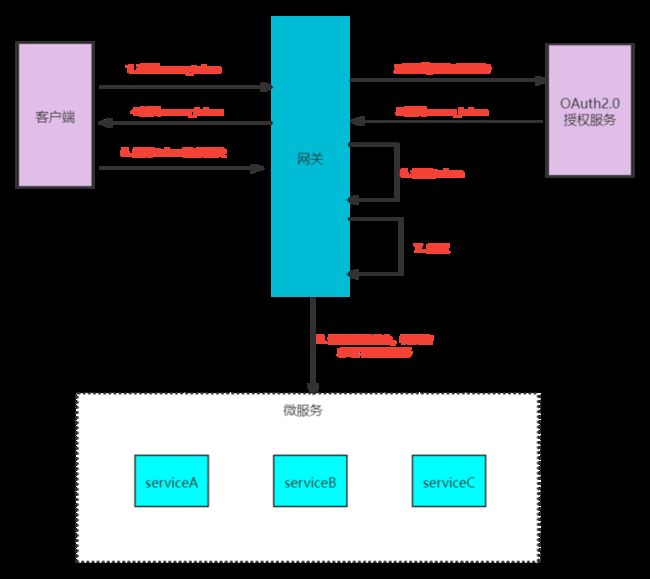大家好,我是不才陈某~
这是《Spring Cloud 进阶》第39篇文章,前面的文章中介绍了网关集成Spring Security实现网关层面的统一的认证鉴权。
有不清楚的可以看之前的文章:实战干货!Spring Cloud Gateway 整合 OAuth2.0 实现分布式统一认证授权!
最近订阅了《Spring Cloud Alibaba 实战》视频专栏的读者经常问陈某两个问题,如下:
- 鉴权放在各个微服务中如何做?
- feign的调用如何做到的鉴权?
今天针对以上两个问题深入聊聊如何通过三个注解解决。
实现思路
前面的几篇文章陈某都是将鉴权和认证统一的放在了网关层面,架构如下:
微服务中的鉴权还有另外一种思路:将鉴权交给下游的各个微服务,网关层面只做路由转发。
这种思路其实实现起来也是很简单,下面针对网关层面鉴权的代码改造一下即可完成:实战干货!Spring Cloud Gateway 整合 OAuth2.0 实现分布式统一认证授权!
1. 干掉鉴权管理器
在网关统一鉴权实际是依赖的鉴权管理器ReactiveAuthorizationManager,所有的请求都需要经过鉴权管理器的去对登录用户的权限进行鉴权。
这个鉴权管理器在网关鉴权的文章中也有介绍,在陈某的《Spring Cloud Alibaba 实战》中配置拦截也很简单,如下:
除了配置的白名单,其他的请求一律都要被网关的鉴权管理器拦截鉴权,只有鉴权通过才能放行路由转发给下游服务。
看到这里思路是不是很清楚了,想要将鉴权交给下游服务,只需要在网关层面直接放行,不走鉴权管理器,代码如下:
http
....
//白名单直接放行
.pathMatchers(ArrayUtil.toArray(whiteUrls.getUrls(), String.class)).permitAll()
//其他的任何请求直接放行
.anyExchange().permitAll()
.....2. 定义三个注解
经过第①步,鉴权已经下放给下游服务了,那么下游服务如何进行拦截鉴权呢?
其实Spring Security 提供了3个注解用于控制权限,如下:
@Secured@PreAuthorize@PostAuthorize
关于这三个注解就不再详细介绍了,有兴趣的可以去查阅官方文档。
陈某这里并不打算使用的内置的三个注解实现,而是自定义了三个注解,如下:
1.@RequiresLogin
见名知意,只有用户登录才能放行,代码如下:
/**
* @author 公众号:码猿技术专栏
* @url: www.java-family.cn
* @description 登录认证的注解,标注在controller方法上,一定要是登录才能的访问的接口
*/
@Retention(RetentionPolicy.RUNTIME)
@Target({ElementType.METHOD, ElementType.TYPE})
public @interface RequiresLogin {
}2.@RequiresPermissions
见名知意,只有拥有指定权限才能放行,代码如下:
/**
* @author 公众号:码猿技术专栏
* @url: www.java-family.cn
* @description 标注在controller方法上,确保拥有指定权限才能访问该接口
*/
@Retention(RetentionPolicy.RUNTIME)
@Target({ElementType.METHOD, ElementType.TYPE})
public @interface RequiresPermissions {
/**
* 需要校验的权限码
*/
String[] value() default {};
/**
* 验证模式:AND | OR,默认AND
*/
Logical logical() default Logical.AND;
}3.@RequiresRoles
见名知意,只有拥有指定角色才能放行,代码如下:
/**
* @author 公众号:码猿技术专栏
* @url: www.java-family.cn
* @description 标注在controller方法上,确保拥有指定的角色才能访问该接口
*/
@Retention(RetentionPolicy.RUNTIME)
@Target({ElementType.METHOD, ElementType.TYPE})
public @interface RequiresRoles {
/**
* 需要校验的角色标识,默认超管和管理员
*/
String[] value() default {OAuthConstant.ROLE_ROOT_CODE,OAuthConstant.ROLE_ADMIN_CODE};
/**
* 验证逻辑:AND | OR,默认AND
*/
Logical logical() default Logical.AND;
}以上三个注解的含义想必都很好理解,这里就不再解释了....
3. 注解切面定义
注解有了,那么如何去拦截呢?这里陈某定义了一个切面进行拦截,关键代码如下:
/**
* @author 公众号:码猿技术专栏
* @url: www.java-family.cn
* @description @RequiresLogin,@RequiresPermissions,@RequiresRoles 注解的切面
*/
@Aspect
@Component
public class PreAuthorizeAspect {
/**
* 构建
*/
public PreAuthorizeAspect() {
}
/**
* 定义AOP签名 (切入所有使用鉴权注解的方法)
*/
public static final String POINTCUT_SIGN = " @annotation(com.mugu.blog.common.annotation.RequiresLogin) || "
+ "@annotation(com.mugu.blog.common.annotation.RequiresPermissions) || "
+ "@annotation(com.mugu.blog.common.annotation.RequiresRoles)";
/**
* 声明AOP签名
*/
@Pointcut(POINTCUT_SIGN)
public void pointcut() {
}
/**
* 环绕切入
*
* @param joinPoint 切面对象
* @return 底层方法执行后的返回值
* @throws Throwable 底层方法抛出的异常
*/
@Around("pointcut()")
public Object around(ProceedingJoinPoint joinPoint) throws Throwable {
// 注解鉴权
MethodSignature signature = (MethodSignature) joinPoint.getSignature();
checkMethodAnnotation(signature.getMethod());
try {
// 执行原有逻辑
Object obj = joinPoint.proceed();
return obj;
} catch (Throwable e) {
throw e;
}
}
/**
* 对一个Method对象进行注解检查
*/
public void checkMethodAnnotation(Method method) {
// 校验 @RequiresLogin 注解
RequiresLogin requiresLogin = method.getAnnotation(RequiresLogin.class);
if (requiresLogin != null) {
doCheckLogin();
}
// 校验 @RequiresRoles 注解
RequiresRoles requiresRoles = method.getAnnotation(RequiresRoles.class);
if (requiresRoles != null) {
doCheckRole(requiresRoles);
}
// 校验 @RequiresPermissions 注解
RequiresPermissions requiresPermissions = method.getAnnotation(RequiresPermissions.class);
if (requiresPermissions != null) {
doCheckPermissions(requiresPermissions);
}
}
/**
* 校验有无登录
*/
private void doCheckLogin() {
LoginVal loginVal = SecurityContextHolder.get();
if (Objects.isNull(loginVal))
throw new ServiceException(ResultCode.INVALID_TOKEN.getCode(), ResultCode.INVALID_TOKEN.getMsg());
}
/**
* 校验有无对应的角色
*/
private void doCheckRole(RequiresRoles requiresRoles){
String[] roles = requiresRoles.value();
LoginVal loginVal = OauthUtils.getCurrentUser();
//该登录用户对应的角色
String[] authorities = loginVal.getAuthorities();
boolean match=false;
//and 逻辑
if (requiresRoles.logical()==Logical.AND){
match = Arrays.stream(authorities).filter(StrUtil::isNotBlank).allMatch(item -> CollectionUtil.contains(Arrays.asList(roles), item));
}else{ //OR 逻辑
match = Arrays.stream(authorities).filter(StrUtil::isNotBlank).anyMatch(item -> CollectionUtil.contains(Arrays.asList(roles), item));
}
if (!match)
throw new ServiceException(ResultCode.NO_PERMISSION.getCode(), ResultCode.NO_PERMISSION.getMsg());
}
/**
* TODO 自己实现,由于并未集成前端的菜单权限,根据业务需求自己实现
*/
private void doCheckPermissions(RequiresPermissions requiresPermissions){
}
}其实这中间的逻辑非常简单,就是解析的Token中的权限、角色然后和注解中的指定的进行比对。
@RequiresPermissions这个注解的逻辑陈某并未实现,自己根据业务模仿着完成,算是一道思考题了....
4. 注解使用
比如《Spring Cloud Alibaba 实战》项目中有一个添加文章的接口,只有超管和管理员的角色才能添加,那么可以使用@RequiresRoles注解进行标注,如下:
@RequiresRoles
@AvoidRepeatableCommit
@ApiOperation("添加文章")
@PostMapping("/add")
public ResultMsg add(@RequestBody @Valid ArticleAddReq req){
.......
} 效果这里就不演示了,实际的效果:非超管和管理员角色用户登录访问,将会直接被拦截,返回无权限。
注意:这里仅仅解决了下游服务鉴权的问题,那么feign调用是否也适用?
当然适用,这里使用的是切面方式,feign内部其实使用的是http方式调用,对于接口来说一样适用。
比如《Spring Cloud Alibaba 实战》项目中获取文章列表的接口,其中会通过feign的方式调用评论服务中的接口获取文章评论总数,这里一旦加上了@RequiresRoles,那么调用将会失败,代码如下:
@RequiresRoles
@ApiOperation(value = "批量获取文章总数")
@PostMapping(value = "/list/total")
public ResultMsg> listTotal(@RequestBody @Valid List param){
....
} 总结
本文主要介绍了微服务中如何将鉴权下放到微服务中,也是为了解决读者的疑惑,实际生产中除非业务需要,陈某还是建议将鉴权统一放到网关中。
最后说一句(别白嫖,求关注)
陈某每一篇文章都是精心输出,已经写了3个专栏,整理成PDF,获取方式如下:
- 《Spring Cloud 进阶》PDF:关注公众号:【码猿技术专栏】回复关键词 Spring Cloud 进阶 获取!
- 《Spring Boot 进阶》PDF:关注公众号:【码猿技术专栏】回复关键词 Spring Boot进阶 获取!
- 《Mybatis 进阶》PDF:关注公众号:【码猿技术专栏】回复关键词 Mybatis 进阶 获取!
如果这篇文章对你有所帮助,或者有所启发的话,帮忙点赞、在看、转发、收藏,你的支持就是我坚持下去的最大动力!

